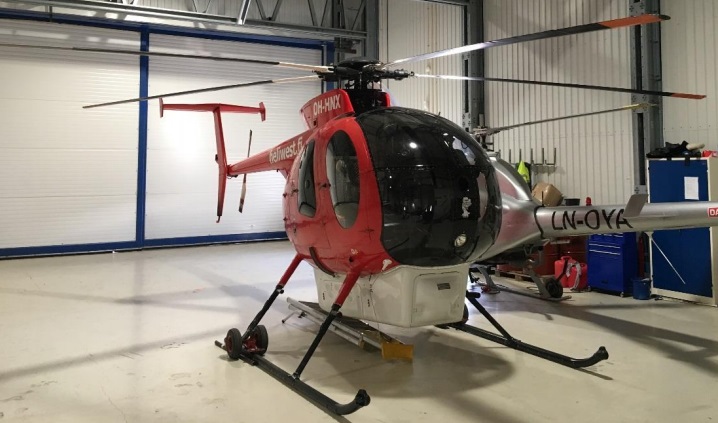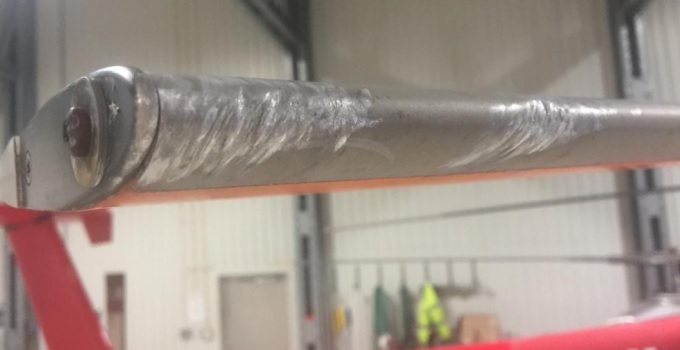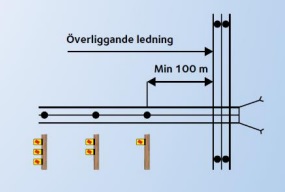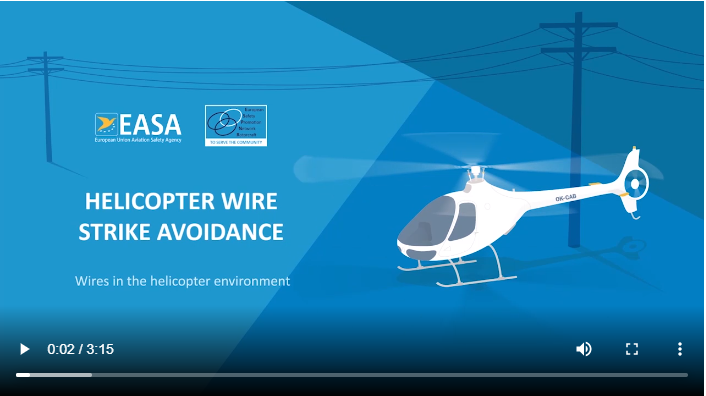Helicopter Wirestrike During Powerline Inspection (HU369D, OH-HNX, Norway)
On 21 June 2018 OH-HNX, a Hughes 369D (500D) helicopter of Heliwest hit a crossing power line 10 km NW of Grimstad, Norway while laser scanning a powerline. It cut all three conductors but was able to land safely with only minor damage.
The Accident Investigation Board Norway (AIBN) say in their safety investigation report this was “very close to a total loss”.
History of the Accident Flight
Heliwest was contracted by Agder Energi Nett to inspect the condition of the power lines in the company’s 22 kV distribution network and the proximity of surrounding vegetation in the surrounding area. The company provides electricity to 199,000 customers and have 20,600 km of lines. Agder Energi Nett has a framework contract with two helicopter companies (assessed on a 50% cost / 50% other factor basis).
The survey was to be conducted photographically and using laser scanning (LIDAR) with a crew of two (a pilot and a systems operator). The mapping equipment on board was calibrated with focus at a 45 m distance which necessitated long duration, high risk, low altitude operations.
Heliwest specialises in supplying helicopter for the energy sector under EASA SPO rules and have extensive experience with this type of task. They were familiar with the conditions in Norway and had previously flown for both TrønderEnergi Nett and Hafslund Nett.
OH-HNX arrived in Norway on 6 June 2018 and made its first inspection flight from Arendal Airport Gullknapp (ENGK) two days later.

H369D OH-HNX in the Hangar after the Accident: The LIDAR is in the White Belly Pod. Note the Helicopters is not WSPS Equipped (Credit: The Powerline Company via AIBN)
According to the AIBN:
The evening before the accident occurred [20 June 2019], the crew planned the flight by e.g. drawing the power lines to be inspected the next day on a paper map. Due to a lapse, the crossing line in question with which the helicopter later collided, had not been registered or drawn on the map.
The crew had only planned to fly one sortie on 21 June 2019 because they were going to fly back to their main base at Helsinki-Malmi that afternoon in connection with Midsummer’s Eve celebrations that evening.
The crew were accommodated in Mandal, and on the morning of 21 June 2018:
…they ate breakfast before driving approx. one hour and 20 minutes to Gullknapp, where they arrived at approx. 07:20. They then completed a pre-flight check on the helicopter, prepared the equipment and signed a dedicated checklist for line inspection flights prepared by Heliwest. This checklist contained multiple safety-related items, including the item “Daily risk analysis”.
The helicopter took off at 08:45. It was flown by the commander in the left seat. Apart from the helicopter’s instruments, he used an iPad with the application Air Navigation Pro for general navigation. The systems operator was in the right seat. There was a navigation display in front of him to the left. The display used the software Vimap and showed a map with the power lines to be inspected. There was a large screen (main screen) in front and to the right of the systems operator which showed the results from the photography and scanning.
When the accident occurred, there was a problem with the Vimap software to the effect that it was not possible to enter digital map information about crossing power lines.
They also [therefore] had the paper map the crew had prepared the evening before. On this map they e.g. marked the lines they had documented.
They flew 40 – 50 m above the line to be inspected at a speed of 80 – 100 km/h (43 – 54 kt). On their way north in the area north-west of Grimstad, the commander suddenly discovered a crossing power line at the same altitude as the helicopter and immediately effected an evasive manoeuvre to the left.
At this time, the systems operator was looking at the main screen and heard the commander yell crossing line. When he looked up, he saw the power line pass above.
The incident occurred in hilly forested terrain… At the intersection, the 22-kV line was 7.4 – 7.9 m above the terrain and the 132-kV line crossed 60 m above the 22-kV line. The pylons for the 132-kV line were on two peaks 584 m apart. Both of these peaks are approx. 200 m above sea level, while the lowest point of the valley between the two peaks is approx. 125 m. Due to elevation differences in the terrain, a corridor in the forest was not needed under the 132-kV line. [which] was not visually marked. Neither was it subject to a marking requirement because less than 100 metres of the line was more than 60 metres above the terrain.
The crew were unsure if they had hit the power line but did fell vibrations and aborted the inspection.
Once he ascertained that he had full control of the helicopter, the commander decided to fly approx. 21.5 km back to Gullknapp, where they landed at 10:58.
After the landing the crew notified their who reported it to their customer as a “close call” at 15:33.
At this point it was already clear that a power line outage had occurred at 10:48 and Agder Energi Nett had initiated an extensive effort to find the cause of the line fault.
Closer investigations of the helicopter revealed damage to the tips of three rotor blades.
It became clear that the helicopter had cut all three conductors in a 132-kV power line.
…All five main rotor blades had to be replaced. The damage to the main rotor also resulted in extensive replacements and overhauls of components in the main rotor, the main rotor transmission and the engine.
Investigation and Further Context
The commander has explained that the windows in the helicopter were clean and that glare was not a factor. However, they were flying with baseball caps on their heads that blocked the upward view. In addition to the fact that the power lines were very difficult to spot against the dark background, the use of caps may have been a factor contributing toward not spotting the line.
Heliwest reviewed the accident in a meeting on 29 June 2018. This included a review of the company’s risk assessments of Aerial Work [which] did not contain a dedicated item on the risk of colliding with crossing power lines during implementation of line inspections.
Past incidents in Norway in early 2018:
When asked by the AIBN whether the error in the Vimap software mentioned [above] had been reported, the company stated that it had not. According to the systems operator, the software issues were solved after the accident. Further, both the navigation display and main display also got audio warnings and visual warnings when they approached a crossing line entered in the system.
On 18 January 2018, a helicopter from Pegasus Helicopter AS was close to colliding with a crossing power line in Marnardal municipality in Vest-Agder County. The helicopter (LN-OST) was flying line inspections for Agder Energi Nett. The serious aircraft incident is described in the AIBN’s report 2019/07.
On 13 February 2018, a helicopter from Fonnafly AS was close to colliding with a crossing power line during line inspections for Agder Energi Nett. The power line was marked and known, but attention lapsed for a moment and an evasive manoeuvre became necessary to avoid the crossing line.
Powerline marking:
Owners of power lines in Sweden and Finland have been required to mark power line pylons before crossing lines. In Sweden, the last three pylons before the crossing must bear signage. [Hammarprodukter video]
There is also extra signage if more than one line is crossing, if the crossing line is more than 10 metres above the line to be inspected, or if lines run close to each other. Heliwest has stated that they had good experiences with such signage.
In Norway, Helgeland Kraft has already marked all their lines. This signage is simpler than that in Sweden.
Agder Energi Nett had considered marking all power lines with signs before crossing lines. However, they were somewhat reluctant to start posting signs for fear of potential subsequent legal requirements introducing new standards that required marking with other types of signs. After the accident, the company decided to mark all power lines.
AIBN Analysis
Over a six-month period three contractors flying for Agder Energi Nett had crossing line occurrences while operating along the company’s power distribution net.
The AIBN believes that OH-HNX was very close to a total loss when it hit the crossing power line.
The fact that the helicopter did not crash in this instance was due to the conductors being struck by the very tips of the main rotor blades. Rotation speed at the tips is approx. 743 km/h. When the rotor hit the conductors, the relative speed between the blade tips and conductors was 823 – 843 km/h. This meant that the rotor blades had enough kinetic energy to cut the conductors without the rotor system sustaining immediate critical damage.
In relation to spotting the wires:
Overhead cables are generally very difficult to spot when they are viewed against terrain or other dark backgrounds. The power line in question was not physically marked, which also was not a requirement.
The overhead cables were so high over the terrain that a power corridor had not been cut in the forest and the pylons were far to the sides of the helicopter’s route. These factors may have contributed toward the limited visibility of the overhead cables.
The commander started a {late] turn to the left to avoid the collision. Had the main rotor disc remained horizontal, there is a chance that the helicopter could have passed under the conductors without touching them.
Having detected vibrations:
..the AIBN believes it was unfortunate that they continued to fly approx. 21.5 km before landing and inspecting the damage… The area was forested and rugged, but on their way to Gullknapp they passed multiple fields and open plains that could have been used as emergency landing sites.
On the subject of the customer, AIBN comment that…
…clients appear to have a tendency to presume that their expected safety is safeguarded as long as the company or the person flying is approved by the authorities.
The client did not stipulate special safety requirements for the helicopter company.
They note that such operators do now need a Safety Management System (SMS) but that…
…it can be demanding to verify the appropriateness when the system is applied.
The AIBN believes that the client (procurer) must have the necessary competence and undertake its own safety assessments of important parameters such as the suitability of the helicopter type, adaptation of equipment, experience and language and cultural differences when agreements are entered into…[and]…must continuously work to ensure that safety margins are as extensive as possible.
When a customer doesn’t have the in-house expertise they do have the option of hiring competent advisory support. AIBN note that have access to competent aviation expertise is”…particularly relevant for net companies in instances where personnel from the net companies are on board the helicopter”. The same applies to all customers whose personnel are to fly on chartered aircraft.
In relation to Geographic Information Systems (GIS) and other mapping data:
One important point before work starts along power lines is that all necessary map information must be made available and used. Crossing lines can be marked on paper maps, but with various automatic notification systems available, it is important that data can be transferred electronically. This may constitute an important barrier in addition to the commander’s observation from the cockpit.
The commander had information about the crossing power line on his electronic maps on the iPad. However, when flying at high speed at low altitude over the terrain, the commander must direct his attention out of the cockpit to the greatest possible extent.
If the crossing line had been in the [Vimap] database, the systems operator could have notified the commander that they were approaching a crossing line. He could then have reduced the speed and potentially undertaken a fly-over at a safe altitude to obtain an overview of the situation before he continued mapping the 22-kV line. In the instance in question, the Vimap company was unable to enter crossing lines in the database due to a software error.
In the opinion of the AIBN, this entailed the loss of a safety barrier that should have been reported as a non-conformance internally in Heliwest.
Heliwest has designated a 10% reduced flight speed as a measure following the accident. The AIBN believes that this will provide a marginally improved reaction time and reduced workload on board, but could hardly have prevented the accident from occurring. In the view of the AIBN, the fact that Vimap has subsequently been upgraded to warn about crossing lines is an important contribution toward improving safety, given that data about all relevant lines is available.
AIBN note that when crews are deployed away from base for long periods “this poses certain challenges as regards follow-up and safety management”. However, in this case the AIBN see no direct connection between the accident and the deployment but do suggest that…
…Heliwest should consider whether the company has an adequate overview of the operations that take place out of view of the company’s management.
In relation to cable marking:
The risk of colliding with crossing lines is very real and must be prevented with barriers at multiple levels. The recent incidents and the accident involving OH-HNX have shown that the measures that have so far been implemented are largely based on people not making mistakes. In connection with work along power lines, both people and sensor equipment will primarily aim their attention at the power line and associated pylons and poles. Warning signs that are physically mounted on the poles, and notify that a crossing line is coming up, will most likely be easier to notice. The AIBN believes that such warning signage could constitute an important safety barrier and is issuing a safety recommendation concerning this.
AIBN Safety Recommendation
Safety Recommendation SL no. 2019/01T: Sweden and Finland have introduced requirements for physical marking of power lines before they are crossed by overhead cables. The AIBN believes such marking could, to a substantial degree, prevent the risk of collision. The Accident Investigations Board Norway recommends that the Civil Aviation Authority introduce requirements for physical marking of crossing lines in Norway.
Safety Resources
- The Tender Trap – the design of aviation service tenders and contracts
- Firefighting Helicopter Wire Strike
- Fatal Wire Strike on Take Off from Communications Site
- Beware Last Minute Changes in Plan
- FAA report: Safety Study of Wire Strike Devices Installed on Civil and Military Helicopters
- Loose Engine B-Nut Triggers Fatal Forced Landing
- Fatal Engine Power Loss: Powerline Helicopter Not Modified IAW OEM Recommendations
- Fatal H500 / 369D Low Altitude Hover Power Loss: Power Line Maintenance Project
- Tool Bag Takes Out Tail Rotor: Fatal AS350B2 Accident, Tweed, ON
- Unexpected Load: AS350B3 USL / External Cargo Accident in Norway
- UPDATE 16 September 2019: Fatal Snowy Powerline Inspection Flight
- UPDATE 27 December 2019: Fatal Powerline Human External Cargo Flight
- UPDATE 21 February 2020: Fatal MD600 Collision With Powerline During Construction
- UPDATE 30 May 2020: Fatal Wisonsin Wire Strike When Robinson R44 Repositions to Refuel
- UPDATE 26 July 2020: Impromptu Landing – Unseen Cable
- UPDATE 20 September 2020: Hanging on the Telephone… HEMS Wirestrike
- UPDATE 23 January 2021: US Air Ambulance Near Miss with Zip Wire and High ROD Impact at High Density Altitude
- UPDATE 5 March 2021: Wire Strike on Unfamiliar Approach Direction to a Familiar Site
- UPDATE 14 August 2022: Second Time Unlucky: Fatal Greek Wirestrike High-Wire Illusion
- UPDATE 3 September 2022: Garbage Pilot Becomes Electric Hooker
The European Safety Promotion Network – Rotorcraft (ESPN-R) has published this video and guidance with EASA:






Recent Comments